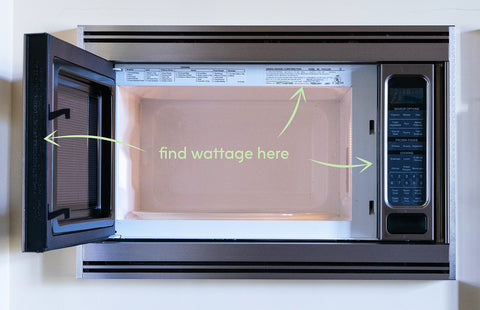Okay, so now that you know why you should cook in the microwave, now the question is: how do you actually do it?!
We've racked up hundreds of hours on our microwave and have a few starting tips to getting the best results.
Keep the moisture in your food with a really good lid.
This is the most important tip for cooking great food in the microwave. There are two main reasons for this:
First, you need the moisture to keep your food moist! The microwave is good at heating up water molecules in your food — this is what makes it cook so fast. But the snag is that water (e.g. moisture) will turn into steam when it starts to boil. If you don't have a secure, heavy lid to keep that steam locked in, it will evaporate. The result? Dry, tough, and rubbery food. A solid lid traps steam in the dish, and you get the best of both worlds: moist, juicy food — super fast.
Secondly, the moisture and steam will help cook your food more evenly. Microwaves can have "hot spots" and "cold spots" in them depending on where the microwaves bounce around. A good lid ensures the steam that comes off the food will circulate the entire dish and cook all the food more evenly, even if the microwaves aren't directly hitting it.
But you need to make sure your lid has an “escape hatch” for excess steam that’s building up pressure in the dish. You don’t want this pressure to blow off the lid! It's kind of like baking a loaf of sourdough without scoring it first — the steam will make the loaf burst out in an unexpected, uncontrolled way.
That's why all of the Anyday Dishes have a heavy, secure glass lid with a silicone rim. Not only does it completely prevent sauce splatters, it also keeps the steam and moisture in the dish. The lids also have a knob that vents the excess steam when it's lifted, and why our recipes tell you to lift the knob to cook! But don't worry if you forget — we've designed the silicone rim on the lid to be flexible enough so that it safely and gently pushes up if the pressure in the dish gets too high. You're covered either way.

Cook for the right amount of time
Know your microwave wattage
Every microwave has its sweet spot when it comes to cook times.That's because they come in all different wattages, which translates to how powerful your microwave is. Microwave wattages typically range from 700 to 1200 watts (w). The higher the wattage, the faster your food will cook. The lower the wattage, the longer the cook time.
To find your microwave's wattage, take a look at the front panel, the side of the door, in the back, or in the user manual. You can also Google the microwave model number to find wattage. If you see both an input and output wattage listed, use the output.

Once you know your microwave wattage, our recipe and ingredient guide cook times can be customized to suit it. If your wattage isn't listed, choose the closest higher wattage.
Our recipes typically give a range for cook times, but we recommend always starting with less time. You can always add more, but you can't take away. (New Anyday users are always surprised by just how fast the microwave is!)
Use the right power level
Did you know your microwave has different power levels? The default power level for every microwave is full power (also called Power Level 10, or 100%, or High), but cooking everything at this level is like always using high heat or broil on your stove or oven.
There are times when you just need more finesse, whether that's for steaming rice at a gentle simmer (grains tend to bubble over if cooked at full power), poaching fish, steaming chawanmushi (Japanese egg custard), or making cheesecake.
Different microwaves have different settings. See your microwave manual (or look it up online) to learn how to change your microwave’s power level.
For many microwaves: enter the cook time, press the “Power” (or “Power Level”) button, and select a number between 1-10. Other microwaves may require selecting the Power Level first, and then entering the cook time.
Microwaves list power levels in different ways. Here’s a guide to help you adjust:
PL 10 = 100% = High (default)
PL 9 = 90% = High
PL 8 = 80% = Med-High
PL 7 = 70% = Med-High
PL 6 = 60% = Medium
PL 5 = 50% = Medium
PL 4 = 40% = Med-Low
PL 3 = 30% = Med-Low
PL 2 = 20% = Low
PL 1 = 10% = Low
You will know if the power level has been successfully changed if you hear periodic changes in the microwave’s tone after it begins cooking.
Cook foods and dishes that suit the microwave's superpowers
Microwave cooking is ideal for water-based cooking such as steaming, poaching, or fast braising. Any vegetable can be cooked to tender-crisp perfection in a matter of a few minutes start to finish.
Lean proteins like fish and chicken cook quickly when microwaved, and stay juicy thanks to the Anyday’s ability to trap and retain moisture in the dish.
It’s also easy to make perfectly steamed grains like rice, polenta, or quinoa using a lower power level. Other foods that can be cooked perfectly in the microwave include ground beef, bacon, scrambled eggs, pasta, and toasted nuts.
We love using the microwave as a middle step to cut down on a lot of time in recipes, too! Parcook potatoes or chicken and finish them on the stove or under the broiler to get a nice sear.
Ready to start cooking? Cook any ingredient perfectly in the Anyday with our Basics or start with some of our Recipes.

-small-portrait.jpeg?v=0)



Share:
David Chang Introduces Anyday
Meet Your Microwave: Your Kitchen's Most Misunderstood Appliance